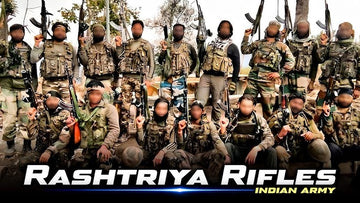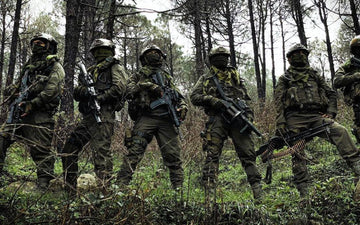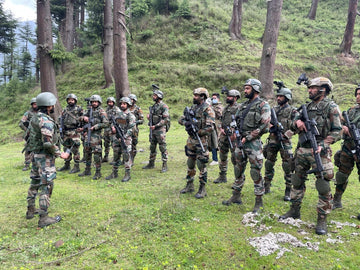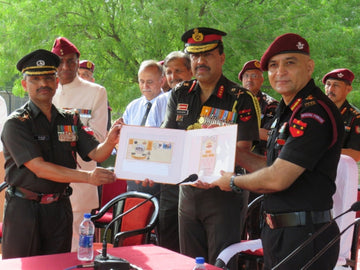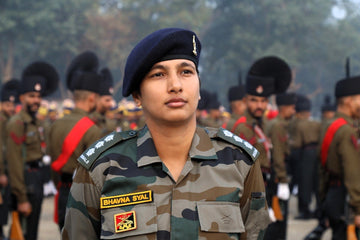The Rashtriya Rifles (RR) represents a critical component of India's security framework, particularly when it comes to counter-insurgency operations in Jammu and Kashmir. Established to address the complex security challenges posed by growing militancy in the region, the Rashtriya Rifles has evolved into a specialized force with a distinctive operational approach. This article delves into the history, structure, role, and effectiveness of the Rashtriya Rifles, shedding light on how it has adapted to meet the demands of modern warfare.
Historical Context
The formation of the Rashtriya Rifles can be traced back to the late 1980s and early 1990s, a tumultuous period characterized by rising unrest in Jammu and Kashmir. The Indian government, recognizing the increasing threat posed by militant groups and separatist movements, decided to create a dedicated force specifically tasked with counter-insurgency operations.
In 1990, the idea was actualized under the leadership of then Prime Minister Vishwanath Pratap Singh, who emphasized the need for a well-organized response mechanism to restore peace in the disturbed regions. The insurgency in Jammu and Kashmir was fueled by demands for increased autonomy, with various militant groups arguing for independence or merger with Pakistan. Faced with this evolving threat, the government sought to establish the Rashtriya Rifles as a force capable of not just tactical military engagement but also fostering a connection with local populations.
Initial Deployments and Structure
The Rashtriya Rifles began its journey with an initial deployment of six battalions, primarily stationed in both the Punjab and Kashmir regions. However, as the intensity of the insurgency grew, the need for a larger force became apparent, leading to an accelerated expansion to 36 battalions within the first year.
These battalions were not formed from scratch; rather, they were composed of personnel reconstituted from existing Indian Army units. This strategy involved sourcing about 10-20% of their personnel from various branches of the army, including infantry, artillery, and armored corps. The diversity in background was intended to create a well-rounded force capable of adapting to rapidly changing operational environments.
However, early deployments faced significant challenges. The mixed composition of soldiers from different regiments resulted in an ineffective command structure and a lack of camaraderie. This led to a restructuring initiative in which each infantry regiment was tasked with creating its own RR battalion, ensuring that these units were headed by their respective commanding officers. This strategy proved to be vastly more effective, enhancing unit cohesion and operational efficiency.
Training and Deployment
Training emerged as a critical component of the Rashtriya Rifles' operational strategy. Each unit underwent a structured 8-week training course at specialized Counter Insurgency (CI) schools, followed by an additional month of stabilization prior to deployment in operational areas. This rigorous training regimen aimed to equip soldiers with the necessary skills to handle the unique challenges posed by insurgency.
To further their operational effectiveness, six RR battalions were exchanged with six units from the Assam Rifles. This not only helped in sharing best practices but also provided the RR soldiers with practical field experience in counter-insurgency operations across different terrains.
Equipment and Resources
The capabilities of the Rashtriya Rifles are not merely a result of personnel training; they are significantly bolstered by the equipment and resources at their disposal. The units were equipped with advanced vehicles, weapons systems, and modern communication tools sourced from the army's war-wastage reserves. Importantly, the RR was among the first to receive protective gear, such as bullet-proof jackets and helmets, further enhancing operational safety for personnel in the field.
Role and Objectives
The core mission of the Rashtriya Rifles is to combat insurgency and maintain law and order in areas plagued by conflict. Their operations are not just limited to military engagement; they also involve community outreach and engagement efforts aimed at building trust with local populations. By fostering dialogue and development projects, the RR seeks to undermine the ideological foundations that fuel militancy.
Operating under the Northern Command of the Indian Army, the Rashtriya Rifles has played a crucial role in mitigating militant activities in Kashmir. Strategies employed include intelligence-gathering, counter-terrorism operations, and active engagement in peace-building initiatives among the local populace.
Composition and Integration
The Rashtriya Rifles prides itself on its diverse composition, integrating personnel from all branches of the army. This all-services approach allows the RR to leverage a wide range of specialized skills and expertise, enhancing its adaptability and effectiveness in complex operational environments. With battalions drawn from various Indian Army units, the RR is capable of executing a multifaceted counter-insurgency strategy that combines technology, combat skills, and community interactions.
Case Studies or Real-world Applications
The Rashtriya Rifles has been involved in numerous operations that highlight its role in counter-insurgency. One notable instance occurred during the 1990s when the RR undertook Operation Sarp Vinash, a targeted effort aimed at neutralizing militant leaders in the Kashmir Valley. The operation not only resulted in the elimination of key insurgent figures but also aimed at regaining the trust of local communities, an essential aspect of effective counter-insurgency.
Another important initiative has been the establishment of the "Sadhbhavna" (Goodwill) program, which focuses on community development and civil affairs. Through this program, the RR has initiated several humanitarian projects, such as building schools, clinics, and infrastructure, thereby addressing the socio-economic issues that often contribute to insurgency.
Statistical Data and Research Insights
The effectiveness of the Rashtriya Rifles can be measured through various statistics. Reports indicate that since the formation of the RR, there has been a discernible decline in militant activities in specific regions of Jammu and Kashmir. For instance, from an average of 500 incidents annually in the early 2000s, the number dropped to approximately 50 incidents by 2020. This reduction reflects both the operational effectiveness of the RR and the broader strategies employed to stabilize the region.
Moreover, the Rashtriya Rifles has been lauded for its ability to integrate local intelligence and community inputs into its operational planning. Studies suggest that incorporating local perspectives significantly improves the success rates of counter-insurgency operations, which has been a key contributing factor to the force's effectiveness.
Challenges and Solutions
While the Rashtriya Rifles has made significant strides in tackling insurgency, it faces ongoing challenges that necessitate continual adaptation and improvement:
- Operational Coordination: The integration of diverse personnel from various army branches, while beneficial, can also lead to communication barriers and operational inefficiencies. Continuous training and cross-unit exercises are essential in overcoming these challenges.
- Civil-Military Relations: Balancing military objectives with the need for civil engagement remains a complex undertaking. The Rashtriya Rifles must continue to prioritize community outreach and develop programs that address local grievances while executing counter-insurgency missions.
- Resource Management: As operational demands grow, maintaining equipment and resources while acquiring advanced technology will be vital. Investment in logistics and supplies, as well as regular updates in training regarding new weapons and systems, remains crucial.
To address these challenges, the Rashtriya Rifles can implement the following solutions:
- Enhanced Training Programs: Regular workshops and joint exercises with civil authorities can improve coordination and response strategies in operating environments.
- Community Engagement Initiatives: Sustained dialogue with community leaders can help build long-term trust and reduce the appeal of militancy.
- Modernizing Communication Infrastructure: Investing in state-of-the-art communication systems can bolster intelligence-gathering and operational execution, ensuring built-in redundancies and improved responsiveness.
Future Trends and Predictions
The future of the Rashtriya Rifles hinges on several emerging trends, including advancements in technology, shifts in geopolitical dynamics, and the evolving nature of insurgency. The integration of artificial intelligence and data analytics into intelligence operations may revolutionize how the RR operates, improving situational awareness and strategic planning.
Moreover, as the socio-political landscape in Jammu and Kashmir continues to evolve, the RR will need to remain flexible, adapting its strategies not only to counter immediate threats but also to address underlying issues contributing to instability.
The growing emphasis on community policing and conflict resolution could see the RR expanding its role from strictly a military force to a more hybrid approach that incorporates aspects of diplomacy and social development. Such shifts may enhance the effectiveness of counter-insurgency while also contributing to long-term peace and stability in the region.
Conclusion
The Rashtriya Rifles stands as a testament to India's proactive approach towards countering insurgency and restoring peace in tumultuous regions. From its initial formation in the early 1990s to its evolution into a specialized force, the RR has continuously adapted to meet the unique challenges posed by an unpredictable security landscape.
Through rigorous training, community engagement, and operational restructuring, the Rashtriya Rifles has established itself as an effective force against terrorism and insurgency. As it faces new challenges and opportunities, the RR's evolution will significantly influence not only the future of security in Jammu and Kashmir but also serve as a model for counter-insurgency efforts worldwide.
Engaging more proactively with local communities and leveraging advanced technologies will be pivotal as the RR continues to play a crucial role in shaping the narrative of peace and stability in the region. The journey of the Rashtriya Rifles thus remains a critical chapter in India's fight against insurgency, with lessons that extend beyond its borders.

